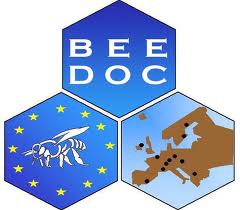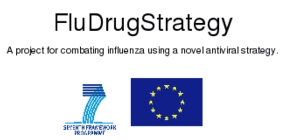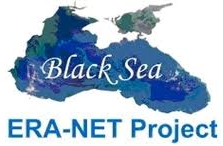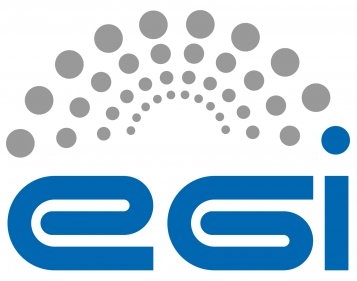|
|
 |
| |
| |
 |
Bees in Europe and the decline of honeybee colonies (BEE DOC)
Start date: 2010-03-01 End date: 2013-02-28
The BEE DOC comprises a network of eleven partners from honeybee pathology, chemistry, genetics and apicultural extension aiming to improve colony health of honeybees. The BEE DOC will empirically and experimentally fill knowledge gaps in honey bee pest and diseases, including the 'colony collapse disorder' and quantify the impact of interactions between parasites, pathogens and pesticides on honey bee mortality. Specifically BEE DOC will show for two model parasites (Nosema and Varroa mites), three model viruses (Deformed Wing Virus, Black Queen Cell Virus, Israel Acute Paralysis Virus) and two model pesticides (fipronil, A-fluvalinate) how interactions affect individual bees and colonies in different European areas. The BEE DOC will use transcriptome analyses to explore host-pathogen-pesticide interaction and identify novel genes for disease resistance. The BEE DOC will specifically address sub lethal and chronic exposure to pesticides and screen how apicultural practices affect colony health. The BEE DOC will develop novel diagnostic screening methods and develop sustainable concepts for disease prevention using novel treatments and selection tools for resistant stock. The BEE DOC will be linked to various national and international ongoing European, North-, and Latin-American colony health monitoring and research programs, which will not only ensure a pan European but also a global visibility and the transfer of results to a worldwide community of beekeepers.
Coordinator for Bulgaria: Prof. DSc. Vassya Bankova
|
| |
 |
Enhancing Access and Services to East European users Towards an efficient and coordinated Pan-European pool of NMR capacities to enable global collaborative research & boost technological advancements (EAST-NMR)
Start date: 2009-02-01 End date: 2013-01-31
Nuclear magnetic resonance (NMR) spectroscopy is a key technology for research in the modern Life Sciences, with an increasing impact on human health. This technology is unique in new areas of molecular systems biology providing detailed insight into protein-protein and protein-ligand interactions.
NMR Research Infrastructures (RIs) are of primary importance by offering the resources necessary to conduct cutting-edge research and support a knowledge base among a broad group of European users. Europe has traditionally enjoyed a leadership role in NMR, but to maintain this position in the face of increasing international competition, scientific and technological capabilities throughout the EU must be fully exploited. This requires the full mobilisation of all European countries, including Eastern Europe, where NMR applications are sparse and tackling challenging scientific projects is less common. Emerging technological and research frontiers must also continue to be addressed. The EAST-NMR project responds to the new challenges facing NMR and its RIs, based on the I3 model. The project will:
• Provide transnational access to NMR instrumentation based in Eastern Europe by taking advantage of the experiences of another on-going European project (EU-NMR, Contract No. RII3-026145EU-NMR) and will provide access to solid-state NMR facilities, an emerging technology at the international level
• Educate and train researchers, especially from Eastern Europe, in NMR’s potential and use
• Advance in sample preparation technologies especially of difficult to tackle membrane proteins through joint research activities.
The project will also influence research throughout the Life Sciences and enhance Pan-European potential for excellence in competitive sectors such as pharmaceuticals and biotechnology.
Coordinator for Bulgaria: Prof. DSc. Svetlana Simova
|
| |
 |
Combating influenza using a novel drug strategy (FLUDRUGSTRATEGY)
Start date: 2008-03-01 End date: 2010-08-31
Objective: To find and produce novel target compounds against the influenza virus. Influenza A capsid protein is the target since it does not mutate at the same rate as the Hemagglutinin or Neuraminidase proteins. We aim to develop new therapeutic antiviral solutions to combat the disease. Beyond state of the art: The project combines knowledge based design and synthesis of compounds with unique patented image analysis and mathematical algorithm software to find and develop new types of potential antiviral molecules. The expertise and methodology allows for rapid discovery of lead molecules with the potential to provide new classes of drugs/vaccines which are less sensitive to viral mutation or reassortment. Work plan: Key molecules with optimal binding kinetics to the Influenza capsid protein will be designed and synthesized then analysed and tested in two separate experimental systems for their effect upon the virus structure and maturation process. The evaluation of novel lead drugs will be performed using a combination of new rapid image analysis, backed up by established viral analysis techniques. Finally a plan will be created for the continued verification and development of the lead molecules. Impact: We aim to produce a new class of antiviral drug candidates which specifically bind to influenza A capsid protein. These substances may have two potential effects; 1. Binding could inhibit important protein-protein interactions thereby inhibit virus formation. 2. Binding to the capsid protein could change the virus structure or stabilize the virus particle, resulting in non-infectious particles to which the host?s immune system could respond. The expected impact will be i) identification of targets against influenza to provide new therapeutic options ii) new opportunities to develop an anti-influenza vaccine which might help prevent an influenza pandemic, iii) to support the continued commercial development of the two SME partners.
Coordinator for Bulgaria: Assoc. Prof. Dr. Lilia Viteva
|
 |
Waste Heat to Electrical Energy via Sustainable Organic Thermoelectric Devices (H2ESOT)
Start date: 2013-01-01 End date: 2015-12-31
H2ESOT is an ambitious project to progress scientific and technical know-how with organic thermoelectric materials. It is estimated that mankind wastes ~20% of the 15 terawatts required annually for global power consumption as low level heat (<200o C). This amounts to 10^20 J/yr, which is greater than the total annual energy usage of all EU member states. Widespread availability of new low-cost organic thermoelectric devices would allow direct heat-to-electrical energy (H2E) from this vast, essentially untapped, resource generating a new industrial sector based on local power generation from otherwise wasted energy sources (engines, boilers, heat pumps, etc.) amounting up to 50 billion €/yr. New materials and devices are needed to achieve such disruptive technology as present approaches are not viable for reasons either of: (i) device inefficiency, and/or (ii) global raw material unavailability preventing widespread implementation. The development of efficient, thermoelectric modules using only low-cost, readily available, renewable and sustainable organic materials would address a range of major transnational FET challenges impacting on energy efficiency, climate change, resources depletion and ‘personalised electricity generation/use’ that will arise within the next decade. To achieve this goal the H2ESOT project is pluri-disciplinary and cross-thematic project from leading European groups able to: prepare, purify, fabricate, test and theoretically define/evolve the organic materials that are needed to fulfil this ‘InnovationEurope 2020’ vision. Europe must reach a position where it can begin to make use of a significant fraction ofits waste heat in order to overcome the immense societal changes associated with sustainable growth andmitigating climate change. Only organic thermoelectric devices ultimately offer the potential for Thermoelectronic(TE) FET that can be widely deployed to recover low level heat. Only H2ESOT has the optimal blend of expertise to develop an appropriate roadmap to such revolutionary new TE materials defining a critically important new industry.
Co-ordinator for Bulgaria: Prof. DSc. Vladimir Dimitrov
|
|
 |
Development of novel antiviral drugs against Influenza (FLUCURE)
Start date: 2010-10-01 End date: 2014-09-30
Influenza viruses cause a highly contagious respiratory disease in both humans and animals. Typically, influenza spreads worldwide in seasonal epidemics resulting in an estimated 3 to 5 million cases of severe illness and 250,000 to 500,000 deaths annually. In addition to these seasonal epidemics there have been several pandemics since the early 1900's, where highly virulent strains emerged, the most devastating being the `Spanish Flu' of 1918, which caused 20-40 million deaths globally. Vaccination is currently the primary means of controlling the spread of influenza virus infections but due to the virus's notorious ability to mutate, new vaccines must be developed each year. There are a few antiviral drugs that are currently on the market; however, their therapeutic potential is restricted through rapid appearance of drug-resistant viruses during treatment. Thus, the need for novel effective drugs against influenza is evident. The FLUCURE project aims at developing innovative, first-in-class therapeutics against influenza by targeting the viral ribonucleoprotein complex, which is replication core of the virion and a major contributor to viral virulence. The high level of conservation combined with slow mutation rates of the ribonucleoprotein complex should result in therapeutics with broad viral strain specificity associated with a reduced risk for developing resistance. FLUCURE builds further on two successful EU-FP7 drug discovery projects, FLUINHIBIT and FluDrugStrategy, both targeting specific but different protein-protein interactions of the viral ribonucleoprotein complex with small molecule inhibitors. A consortium of 10 partners with the required complementary skills will progress the lead candidates from these two projects synergistically through lead optimization and preclinical development phases, with the final objective to deliver one or more drug candidates suitable for entering clinical development within 4 years.
The FLUCURE project is a European collaborative research project coordinated by Vironova AB with the objective to develop novel antiviral compounds that inhibit the influenza A virus. The project is a continuation of a previous EU FP7 funded project, FluDrugStrategy, which was successfully completed in 2010. FluDrugStrategy provides the background work for FLUCURE to produce a new broad spectrum anti-influenza drug. FLUCURE aims to bring the lead anti-influenza candidate compounds resulting from the FluDrugStrategy project through lead optimization and preclinical development phases, with the final goal to deliver drug candidates suitable for entering early clinical development. FLUCURE is a collaboration between five academic partners and four SME industrial partners from Bulgaria, Germany, Italy, Lithuania, Sweden, Switzerland and The Netherlands. The combined extensive expertise of the participants represents a solid platform for the discovery and development of broad spectrum antivirals against influenza A.
Cordinator for Bulgaria: Assoc. Prof. Dr. Lilia Viteva.
|
| |
 |
Networking in Science and Technology in the Black Sea Region (BS-ERA.NET)
Start date: 2011 End date: 2013
The main objectives of the BS-ERA.NET project are: - reduce the fragmentation of the European Research Area (ERA) by improving the coherence and coordination of national and regional research programmes; - to develop and strengthen the coordination of public research programmes conducted at national and regional level, which target a group of countries from the extended Black Sea region. - to sustain the communication in order to develop better reciprocal knowledge and promote trust-building among programme owners and/or managers through a mutual learning process, and a systemic exchange of information and good practice. - to enhance the complementarities and synergy between the Framework Programme and activities carried out in the framework of governmental structures such as COST, EUREKA, NEP, UNESCO-BRESCE or EIROforum. - to promote a network and mutually open at national regional research programmes level which will lead to: concrete cooperation in the frame of the Black Sear Research Programme (BSRP) and to the development and implementation of joint programmes and activities in the region.
Coordinator for Bulgaria: Prof. Dr. Nartzislav Petrov
|
| |
 |
Integrated Sustainable Pan-European Infrastructure for Researchers in Europe (EGI-In-SPIRE)
Start date: 2010-05-01 End date: 2014-05-01
EGI.eu is a not-for-profit foundation established under Dutch law to coordinate and manage the European Grid Infrastructure (EGI) federation on behalf of its participants: National Grid Initiatives (NGIs) and European International Research Organisations (EIROs).
Scientific research is no longer conducted within national boundaries and is becoming increasing dependent on the large-scale analysis of data, generated from instruments or computer simulations housed in trans-national facilities, by using e-Infrastructure (distributed computing and storage resources linked by high-performance networks). The 48 month EGI-InSPIRE project will continue the transition to a sustainable pan-European e-Infrastructure started in EGEE-III. It will sustain support for Grids of high-performance and high-throughput computing resources, while seeking to integrate new Distributed Computing Infrastructures (DCIs), i.e. Clouds, SuperComputing, Desktop Grids, etc., as they are required by the European user community. It will establish a central coordinating organisation, EGI.eu, and support the staff throughout Europe necessary to integrate and interoperate individual national grid infrastructures. EGI.eu will provide a coordinating hub for European DCIs, working to bring existing technologies into a single integrated persistent production infrastructure for researchers within the European Research Area. EGI-InSPIRE will collect requirements and provide user-support for the current and new (e.g. ESFRI) users. Support will also be given for the current heavy users as they move their critical services and tools from a central support model to ones driven by their own individual communities.
The project will define, verify and integrate within the Unified Middleware Distribution, the middleware from external providers needed to access the e-Infrastructure. The operational tools will be extended by the project to support a national operational deployment model, include new DCI technologies in the production infrastructure and the associated accounting information to help define EGI's future revenue model.
Coordinator for Bulgaria: Prof. DSc. Petko Ivanov
|
| |
| |
| |
|
|
|
|
